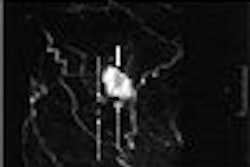For the vast majority of cases, 2D ultrasonography doesn't provide any additional diagnostic information over 3D/4D obstetric ultrasonography exams, according to an article published in the June issue of the Journal of Ultrasound in Medicine.
"Information provided by 2D sonography is consistent, in most cases, with information provided by the examination of 3D/4D volume datasets alone," wrote a research team from the National Institutes of Health (NIH) in Bethesda, MD; Wayne State University in Detroit; and William Beaumont Hospital in Royal Oak, MI (JUM, June 2006, Vol. 25:5, pp. 691-699).
The goal of their study was to determine whether 2D ultrasonography adds diagnostic information to exams conducted using 3D/4D volume datasets alone. Two sonographers prospectively examined 99 fetuses with 3D/4D ultrasonography. The fetal heart was examined using 4D ultrasonography with spatiotemporal image correlation (STIC), and all exams were performed using a Voluson 730 Expert scanner (GE Healthcare, Chalfont St. Giles, U.K.).
After the volume datasets were acquired, an independent examiner who was blinded to the indication for the exam explored the 3D/4D data and established an initial diagnostic impression. Immediately afterward, the same examiner performed a 2D ultrasonographic exam and established a final ultrasonographic diagnosis.
The researchers then compared the frequency of agreement and diagnostic accuracy of each modality to detect congenital anomalies.
Of the 99 fetuses, 54 fetuses were considered to have no abnormalities and 45 fetuses had 82 anomalies diagnosed by 2D ultrasonography. The researchers found agreement between 2D and 3D/4D in 123 of 126 cases (90.4%).
Six anomalies were missed by 3D/4D, including two ventricular septal defects, one interrupted inferior vena cava with azygous continuation, one tetralogy of Fallot, one horseshoe kidney, and one cystic adenomatoid malformation.
Two discordant diagnoses included transposition of the great arteries diagnosed as a double-outlet right ventricle and pulmonary atresia misinterpreted by tricuspid atresia on 3D/4D ultrasonography, according to the researchers.
Also, one case of occult spinal dysraphism was suspected on 3D ultrasonography but was not confirmed by 2D ultrasonography. After comparing diagnoses performed after delivery, 3D/4D produced sensitivity of 92.2% (47/51) and specificity of 76.4% (42/55).
However, 2D ultrasonography yielded sensitivity of 96.1% (49/51) and specificity of 72.7% (40/55). The differences between the techniques were not statistically significant.
Evaluation of fetal anatomy and diagnosis of congenital anomalies is possible by the examination of 3D/4D volume data sets alone, the authors concluded.
"Discordance between 3D/4D and 2D diagnoses generally occurred for volume datasets of poor diagnostic quality and, in two cases, anomalies that were initially overlooked by the examiner could be retrospectively identified by review of the volume datasets," the authors wrote. "The design employed in this study could be used to validate sonographic tomography in diagnostic units considering a more extensive application of this technology in clinical practice."
By Erik L. Ridley
AuntMinnie.com staff writer
June 8, 2006
Related Reading
3D ultrasound brings efficiency gains, May 25, 2006
3D sonography of the endometrium adds value, May 5, 2006
3D ultrasound predicts fetal pulmonary hypoplasia, April 21, 2006
3D ultrasound shows value in detecting fetal malformations, March 24, 2006
3D imaging creates paradox for ultrasound vendors, November 9, 2005
Copyright © 2006 AuntMinnie.com




















